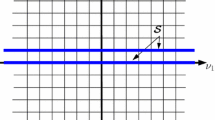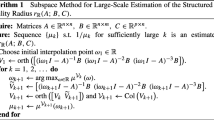Abstract
In this paper, we look into restrictions of the solution set of a system of PDEs to 1-d subspaces. We bring out its relation with certain intersection modules. We show that the restriction, which may not always be a solution set of differential equations, is always contained in a solution set of ODEs coming from the intersection module. Next, we focus our attention to restrictions of strongly autonomous systems. We first show that such a system always admits an equivalent first order representation given by an n-tuple of real square matrices called companion matrices. We then exploit this first order representation to show that the system corresponding to the intersection module has a state representation given by the restriction of a linear combination of the companion matrices to a certain invariant subspace. Using this result we bring out that the restriction of a strongly autonomous system is equal to the system corresponding to the intersection module. Then we look into restrictions of a general autonomous system, not necessarily strongly autonomous. We first define the notion of a free subspace of the domain—a 1-d subspace where every possible 1-d trajectory can be obtained by restricting the trajectories of the autonomous system. Then we give an algebraic characterization of free-ness of a 1-d subspace for a scalar autonomous system. Using this algebraic criterion we then give a full geometric characterization of free (and non-free) subspaces. As a consequence of this we show that the set of non-free 1-d subspaces is a closed linear set in the projective (n−1)-space. Finally, we show that restriction to a non-free subspace always equals the solution set of the ODEs coming from the intersection ideal. As a corollary to this we give a necessary and sufficient condition for a system to be stable in a given direction.
Similar content being viewed by others
Explore related subjects
Discover the latest articles, news and stories from top researchers in related subjects.References
Avelli D. N., Rocha P. (2010) Autonomous multidimensional systems and their implementation by behavioral control. Systems and Control Letters 59(34): 203–208
Cox D., Little J., O’Shea D. (1998) Using algebraic geometry, graduate texts in mathematics. Springer, New York
Cox D., Little J., O’Shea D. (2007) Ideals, varieties, and algorithms, undergraduate texts in mathematics, 3 edn. Springer, New York
Fornasini E., Rocha P., Zampieri S. (1993) State space realization of 2-d finite-dimensional behaviours. SIAM Journal on Control and Optimization 31(6): 1502–1517
Hartshorne R. (2009) Algebraic geometry, graduate texts in mathematics. Springer, New York
Hörmander L. (1990) The analysis of linear partial differential operators I, Grundlehren der mathematischen Wissenschaften, 2 edn. Springer, Berlin
Kojima C., Rapisarda P., Takaba K. (2010) Lyapunov stability analysis of higher order 2-D systems. Multidimensional Systems and Signal Processing 22: 287–302
Oberst U. (1990) Multidimensional constant linear systems. Acta Applicandae Mathematicae 20: 1–175
Oberst, U. (2006). The constructive solution of linear systems of partial difference and differential equations with constant coefficients. In B. Hanzon & M. Hazewinkel (Eds.), Constructive Algebra and Systems Theory (pp. 205–233). The Netherlands: Royal Netherlands Academy of Arts and Sciences.
Oberst U., Pauer F. (2001) The constructive colution of linear systems of partial difference and differential dquations with constant coefficients. Multidimensional Systems and Signal Processing 12: 253–308
Pal, D.,& Pillai, H. K. (2011). On restrictions of n-d systems to 1-d subspaces. In Proceedings of the 7th international workshop on multidimensional (nD) systems. Poitiers.
Pillai H. K., Shankar S. (1998) A behavioral approach to control of distributed systems. SIAM Journal on Control and Optimization 37(2): 388–408
Pillai H. K., Willems J. (2002) Lossless and dissipative distributed systems. SIAM Journal on Control and Optimization 40(5): 1406–1430
Polderman J. W., Willems J. C. (1998) Introduction to mathematical systems theory: A behavioral approach. Springer, New York
Pommaret, J. F. (2005) Algebraic analysis of control systems defined by partial differential equations. In: F. Lamnabhi-Lagarrigue, A., Loría, & E., Panteley (Eds.), Advanced topics in control systems theory: Lecture notes from FAP 2004, chap. 5. (pp. 155–200). Springer, LNCIS.
Pommaret J. F., Quadrat A. (1999) Algebraic analysis of linear multidimensional control systems. IMA Journal of Mathematical Control and Information 16: 275–297
Rocha P., Willems J. (2006) Markov properties for systems described by PDEs and first-order representations. Systems and Control Letters 55: 538–542
Shankar S. (1999) The Nullstellensatz for systems of PDE. Advances in Applied Mathematics 23: 360–374
Sturmfels, B. (2002). Solving systems of polynomial equations. American Mathematical Society with support from the National Science Foundation (2002).
Valcher M. (2001) Characteristic cones and stability properties of two-dimensional autonomous behaviors. IEEE Transactions on Circuits and Systems—Part I: Fundamental Theory and Applications 47(3): 290–302
Zerz E., Oberst U. (1993) The canonical cauchy problem for linear systems of partial difference equations with constant coefficients over the complete r-dimensional integral lattice \({\mathbb{Z}^r}\) . Acta Applicandae Mathematicae 31: 249–273
Author information
Authors and Affiliations
Corresponding author
Rights and permissions
About this article
Cite this article
Pal, D., Pillai, H.K. On restrictions of n-d systems to 1-d subspaces. Multidim Syst Sign Process 25, 115–144 (2014). https://doi.org/10.1007/s11045-012-0194-3
Received:
Revised:
Accepted:
Published:
Issue Date:
DOI: https://doi.org/10.1007/s11045-012-0194-3




